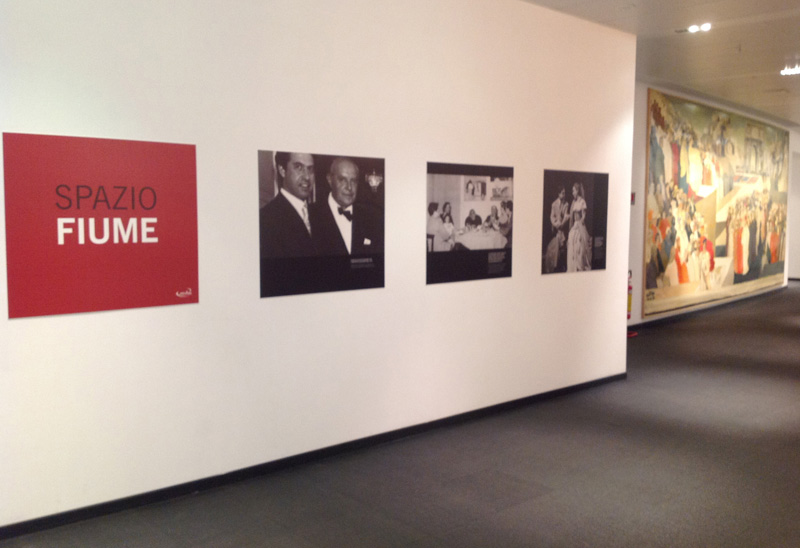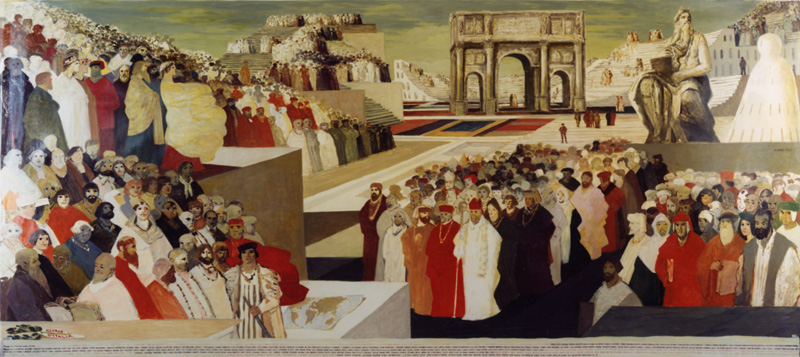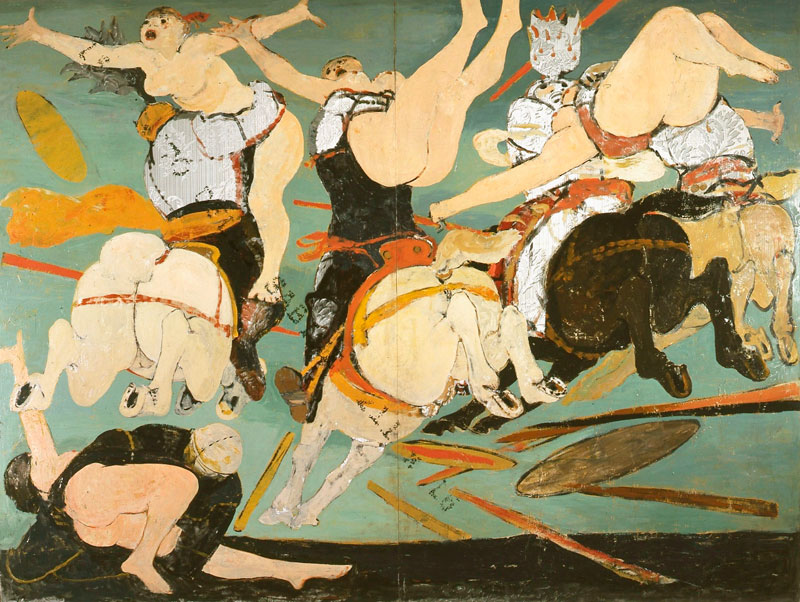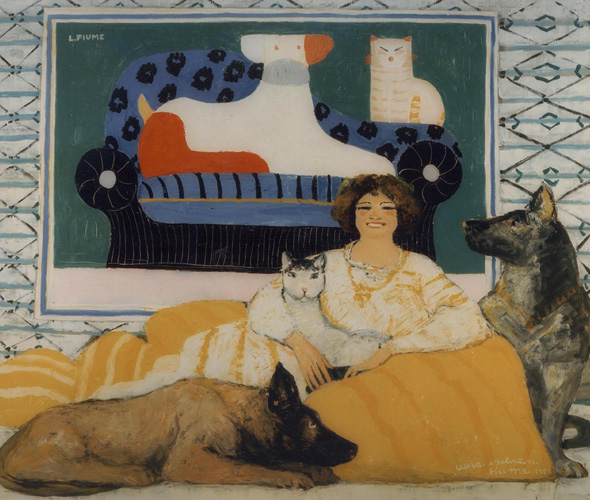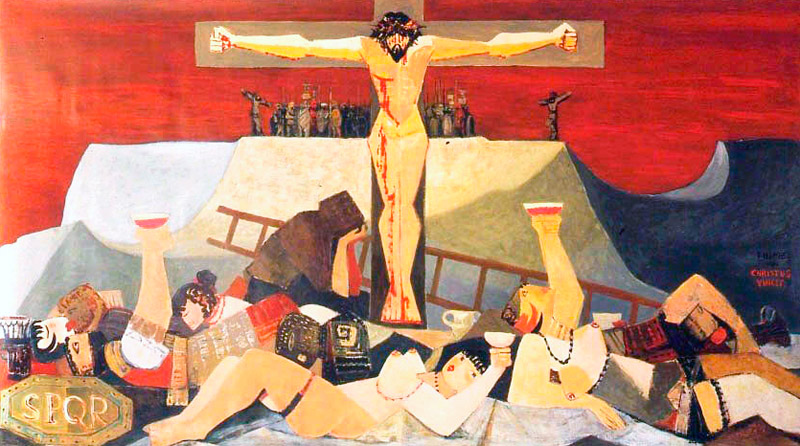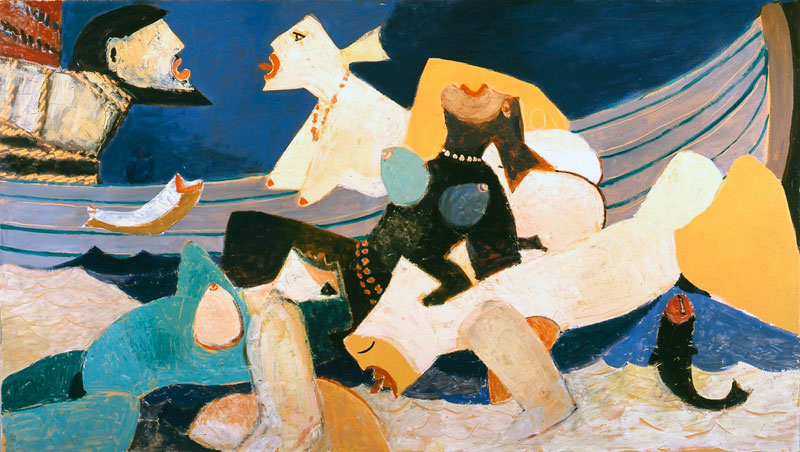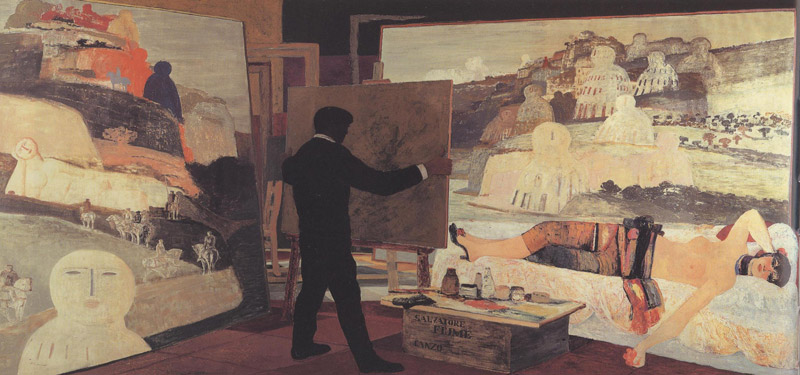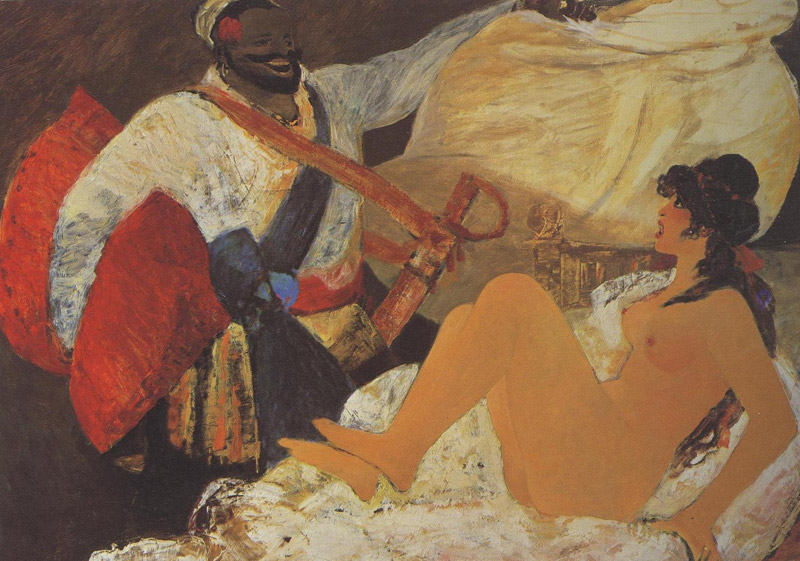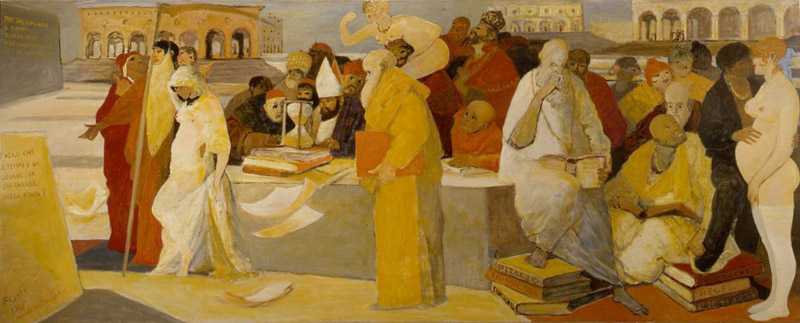PALAZZO LOMBARDIA · MILAN
Thirteen large works by Salvatore Fiume donated to the Lombardy Region by his children Laura and Luciano, are on permanent display in the Spazio Fiume on the first floor of the new Lombardy Region Headquarters. The museum space was inaugurated on the 23rd of October 2012, on the day when Salvatore Fiume would have turned 97. On the same night an exhibition at Palazzo Pirelli, the early Headquarters of the Lombardy Region, was also inaugurated whose title was The Identities of Salvatore Fiume. 50 Works 1940 – 1990. A sculpture by Fiume was also placed on the ground floor, near entrance N4 from which the Spazio Fiume can be accessed. Three large works by Fiume are also on display inside the Foyer of the Auditorium.
WORKS IN THE SPAZIO FIUME
Glories of Italy, 1989
Oil on canvas, 710 cm x 318 cm
This is the largest painting in the collection on display inside the Spazio Fiume at Palazzo Lombardia. It is a tribute to the Italian genius through the representation of many protagonists of Italian history (some of them recognizable, like Dante, Raphael, Michelangelo, and Garibaldi). Behind them a huge crowd of famous yet unidentifiable personalities extends whose names are listed in a very thick caption on the bottom edge of the painting.
Portrait of his son, Luciano, 1981
Oil on masonite, 115 cm x 160 cm
Having trained himself at the great school of the XV Century Italian portraitists and being a great admirer of portraitist Goya, Fiume started very young to carry out portraits of family and friends, first in drawing and later in painting, to continue with historical figures as well as with eminent contemporary figures of culture and entertainment. In 1989 he also created a whole cycle of portraits called My Imaginary Ancestors. In 1973 Fiume painted the African Mona Lisa, now in the Vatican Museums. This painting, together with his successive Japanese Mona Lisa is another tribute by Fiume to Leonardo da Vinci.
The Rape of the Sabine Women, 1985
Oil on wallpaper glued on masonite, 211 cm x 160 cm
This painting does not fall among the most recurrent subjects of Fiume’s, nor does it belong to any of the various cycles he completed during his long career. It is rather a proof of technical skill in which Fiume enjoyed himself in showing how effortlessly he was capable of overcoming difficulties of composition and perspective in the manner of his famous colleagues of the past.
In Laura’s Home, 1987
From the Pictorial Alliances cycle, oil on masonite, 200 cm x 170 cm
This cycle is represented here by a painting carried out by Fiume with his daughter Laura, also a painter, portrayed with her two dogs and her beloved kitten Purù.
Tribute to Goya, 1960
From the Spanish Cycle, oil on canvas, 210 cm x 135 cm
This painting belongs to Fiume’s Tributes to Goya and portrays the Spanish Royal Family standing beside Goya’s famous Maya Desnuda.
The Three Graces, 1994
From the Cycle of the Hypotheses, with elements from Picasso and de Chirico.
Oil on masonite, 230 cm x 170 cm
Christus Vincit, Varese, 1986
Oil on canvas, 500 cm x 270 cm
Fiume’s production of religious works is represented here by this large crucifixion interpreted with an extraordinary expressive freedom.
Ulysses and the Sirens, 1985
Oil on canvas, 500 cm x 270 cm
Although he kept himself within the sphere of a substantially Figurative iconography, Fiume also wanted to express himself through more geometrical forms, of Picassian inspiration. Drawings and paintings encompassing various themes such as Wrestling Dragons, Flower Vases, Models, and even religious themes like Christus Vincit and Ulysses and the Sirens were included in that unusual experience.
Self Portrait in the Atelier, 1985
Oil on canvas, 500 cm x 270 cm
In this painting Fiume represents himself in his studio in the act of starting a model’s portrait. Two of his large paintings on the Island of Statues theme can be seen leaning against the walls.
The Turk’s Discovery, 1982
Oil on canvas, 290 cm x 170 cm
In 1975 the little town of Fiumefreddo Bruzio, Calabria, was enthused by Fiume’s idea of revitalizing its historic centre by executing a number of works as a gift to that town. Starting in that same year Fiume painted the interior walls and some of the exteriors of the old crumbling castle. On them he depicted in an ironic manner scenes of ancient Saracen invasions. Unfortunately with the passing of time most paintings were destroyed by bad weather, so, when Fiume went back home he carried out a cycle of paintings on the same subject, including this Turks’ Discovery of 1982.
Licisca, 1976
Bronze, h 190
In this sculpture Fiume wanted to set in bronze the forms of his female aesthetic ideal.
The Great Questions, 1986
Oil in canvas, 445 cm x 180 cm
This large painting is an example of Salvatore Fiume’s ironic spirit. Here, he imagines a kind of School of Athens where philosophers and scientists from disparate places and schools have gathered in a totally invented agora to debate the great questions haunting humanity.
Horse and Horseman, 1950s
Wire mesh and stucco, h 280 cm
In this sculpture the influence of Marino Marini’s style can be recognized. Marini, together with Arturo Martini and Giovanni Paganin, was one of the twentieth century’s sculptors Fiume respected most.
FIUME’S WORKS IN THE GIOVANNI TESTORI AUDITORIUM FOYER
The Stage, 1959
Oil on canvas, 700 cm x 300 cm
This large painting full with characters is a tribute to the Opera theatre. Among those characters soprano Maria Callas can be seen standing on the right in a light blue gown. On this overcrowded stage Fiume placed himself, seated on the steps in an armour, and his family: on the right, above the drawing of a man, his son Luciano. In the middle his wife and her three sisters, and to the right his daughter Laura, still a child, next to some of her little drawings.
City of Statues, 1977
Fresco painting on concrete, 102 cm x 440 cm
Fresco painting was one of the most hidden aspects of Fiume’s nature as an artist. In fact, he would have preferred to have lived at the time when painters earned their living by frescoing tombs, churches, and palaces. That tradition being extinguished, Fiume painted his frescoes on large rectangular portions of plaster enclosed by a frame like in the case of this City of Statues.
Cock, 1949
Wicker sculpture, h 340 cm
The image of the cock, a symbol of virility, appears in many of Fiume’s bronze sculptures as well as in his architectural projects, drawings, and paintings. Fiume had two sculptures made in wicker, after his own sketches, by the Vittorio Bonacina laboratory of Lurago d’Erba: the Warrior and the Cock, both in 1949. The latter, the larger one, was exhibited a the Triennial of Milan in 1991.






